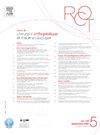Fractures du radius distal après 75 ans : quelles fractures et quels patients opérer ? Évaluation prospective continue pendant les 6 premiers mois
Q4 Medicine
Revue de Chirurgie Orthopedique et Traumatologique
Pub Date : 2024-08-08
DOI:10.1016/j.rcot.2024.07.021
引用次数: 0
Abstract
Introduction
Le traitement chirurgical (TC) et le traitement orthopédique (TO) des fractures du radius distal après 65 ans ont des résultats fonctionnels similaires à 1 an postopératoire. Peu d’études évaluent ces résultats après 75 ans.
Hypothèse
Nous supposons que le TC apporte de meilleurs résultats cliniques et radiologiques que le TO. L’objectif principal de l’étude était de comparer à court terme, les résultats des deux traitements pour toutes fractures confondues et pour les fractures déplacées et très déplacées (bascule > 20°) du radius distal après 75 ans.
Patients et méthodes
Cette étude prospective a inclus en deux ans 74 patients suivis 6 mois minimum. Le traitement dépendait du déplacement de la fracture, des comorbidités (Charlson) et de l’autonomie du patient. Le TC était une ostéosynthèse par plaque antérieure verrouillée à ciel ouvert (n = 24). Le TO était une manchette plâtrée 6 semaines sans réduction (n = 50). Les critères de jugement principaux étaient cliniques (amplitudes articulaires, force, scores EVA (échelle visuelle analogique), QuickDASH (Disabilities of the Arm, Shoulder and Hand), PRWE (Patient Rated Wrist Evaluation) et SF-36 (36-Item Short Form Health Survey). Les critères de jugement secondaires étaient les résultats radiologiques et les complications.
Résultats
Le TC améliorait significativement de 7° : la flexion, l’inclinaison ulnaire, la supination, l’angle dorsal et la variance ulnaire dès 1,5 mois et la pronation et l’index radio-ulnaire distal dès le 6e mois (p < 0,05). Le TC améliorait significativement de 10° : la flexion, l’inclinaison ulnaire, la supination chez les fractures déplacées et très déplacées dès 1,5 mois (p < 0,05).
Discussion
Le TC améliore significativement les résultats cliniques et radiologiques après 75 ans dans les 6 mois post-fracture du radius distal. Le TC est conseillé pour les fractures du radius distal déplacées et très déplacées pour une récupération plus précoce des amplitudes articulaires. Au-delà des 6 mois, les résultats sont équivalents.
Niveau de preuve
III.
Background
Surgery and non-operative treatment produce similar 1-year functional outcomes in patients older than 65 years. Data are lacking for patients older than 75 years. The main objective of this study was to compare surgical vs. non-operative treatment regarding short-term outcomes in patients older than 75 years. In addition to an overall analysis, sub-group analyses were done in patients with displacement and severe displacement (> 20° posterior tilt).
Hypothesis
Surgery provides better clinical and radiological outcomes than does non-operative treatment.
Patients and methods
Patients older than 75 years at the time of a distal radius fracture were included prospectively over a 2-year period. A follow-up duration of at least 6 months was required. Treatment choices were based on displacement, Charlson's Co-morbidity Index, and patient autonomy. Surgery consisted in open fixation using an anterior locking plate and non-operative treatment in a short arm cast without reduction. The main assessment was based on clinical criteria: range of motion, strength, visual analogue scale (VAS) scores, the short version of the Disabilities of the Arm, Shoulder, and Hand tool (QuickDASH), the Patient Rated Wrist Evaluation (PRWE), and the 36-Item Short Form Health Survey (SF-36). The secondary assessment criteria were the radiological outcomes and the complications.
Results
In total, 74 patients were included, among whom 24 were treated surgically and 50 non-operatively. At 1.5 months, surgery was associated with significantly better results for flexion, ulnar inclination, and supination, with range increases of at least 7° vs. non-operative treatment, and with greater dorsal angle and ulnar variance values (P < 0.05 for all comparisons). At 6 months, pronation and the radio-ulnar index were better with surgery (P < 0.05 for both comparisons). In the patients with displacement or severe displacement, surgery was associated with 10° gains vs. conservative treatment for flexion, ulnar inclination, and supination at 1.5 months (P < 0.05 for all comparisons).
Discussion
In patients older than 75 years, surgery for distal radius fracture was associated with significantly better clinical and radiological outcomes within 6 months. Surgery is recommended for displaced and severely displaced distal radius fractures to expedite the recovery of joint motion ranges. Beyond 6 months, the outcomes are similar.
Level of evidence
III.
75 岁以后的桡骨远端骨折:哪些骨折和哪些患者应接受手术?头 6 个月的持续前瞻性评估
导言65岁以上桡骨远端骨折的外科治疗(TC)和矫形治疗(TO)与术后1年的功能结果相似。我们认为,TC 与 TO 相比,可获得更好的临床和放射学结果。这项研究的主要目的是对75岁后桡骨远端骨折(基底面为20°)和桡骨近端骨折(基底面为20°)的两种治疗方法的效果进行初步比较。治疗取决于骨折的位置、合并症(Charlson)和患者的自主性。TC 是一种前壁斑块溃疡性骨折(n = 24)。TO是一种植入 6 个月后仍未缩小的楔形切除术(n = 50)。主要评判标准为临床评分(关节振幅、力量、EVA(视觉模拟评分)、QuickDASH(手臂、肩部和手部残疾)、PRWE(患者腕部评分)和 SF-36(36 项简表健康调查)。其次的评判标准是放射学结果和并发症。结果Le TC 在 1.5 个月时显著改善了 7°:屈曲、尺侧倾斜、上举、背侧角度和尺侧方差,在 6 个月时显著改善了前倾和无线电尺远端指数(p < 0,05)。讨论桡骨远端骨折后 6 个月内,TC 显著改善了 75 岁后的临床和放射学结果。TC适用于桡骨远端移位和严重移位的骨折,可使关节振幅更快恢复。Au-delà des 6 mois, les résultats sont équivalents.Niveau de preuveIII.BackgroundSurgery and non-operative treatment produce similar 1-year functional outcomes in patients older than 65 years.目前尚缺乏 75 岁以上患者的数据。本研究的主要目的是比较手术治疗与非手术治疗对 75 岁以上患者的短期疗效。除总体分析外,还对有移位和严重移位(后倾20°)的患者进行了亚组分析。假设手术治疗比非手术治疗能提供更好的临床和放射学结果。患者和方法前瞻性纳入桡骨远端骨折时年龄大于75岁的患者,为期两年。随访时间至少需要 6 个月。根据移位情况、夏尔森共病指数和患者自主性选择治疗方法。手术包括使用前方锁定钢板进行开放式固定,以及使用短臂石膏进行非手术治疗,但不进行复位。主要评估基于临床标准:活动范围、力量、视觉模拟量表(VAS)评分、短版手臂、肩部和手部残疾工具(QuickDASH)、患者腕部评价(PRWE)和 36 项简表健康调查(SF-36)。次要评估标准为放射学结果和并发症。结果 共纳入 74 例患者,其中 24 例接受手术治疗,50 例接受非手术治疗。1.5个月时,与非手术治疗相比,手术治疗在屈曲、尺侧倾斜和仰卧方面的效果明显更好,范围至少增加了7°,背角和尺侧变异值也更大(所有比较的P均为0.05)。在 6 个月时,手术治疗的患者代偿能力和无线电尺指数更佳(两组比较的 P 均为 0.05)。在有移位或严重移位的患者中,手术治疗与保守治疗相比,在1.5个月时,患者的屈曲度、尺侧倾斜度和上举度增加了10°(所有比较的P均为0.05)。建议对移位和严重移位的桡骨远端骨折进行手术治疗,以加快关节活动范围的恢复。6个月后的结果类似。
本文章由计算机程序翻译,如有差异,请以英文原文为准。
求助全文
约1分钟内获得全文
求助全文
来源期刊

Revue de Chirurgie Orthopedique et Traumatologique
Medicine-Surgery
CiteScore
0.10
自引率
0.00%
发文量
301
期刊介绍:
A 118 ans, la Revue de Chirurgie orthopédique franchit, en 2009, une étape décisive dans son développement afin de renforcer la diffusion et la notoriété des publications francophones auprès des praticiens et chercheurs non-francophones. Les auteurs ayant leurs racines dans la francophonie trouveront ainsi une chance supplémentaire de voir reconnus les qualités et le intérêt de leurs recherches par le plus grand nombre.
 求助内容:
求助内容: 应助结果提醒方式:
应助结果提醒方式:


